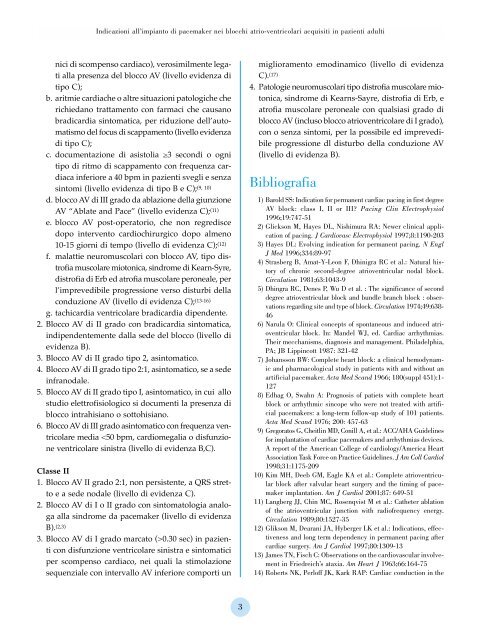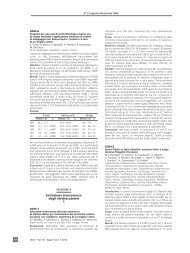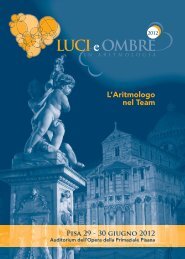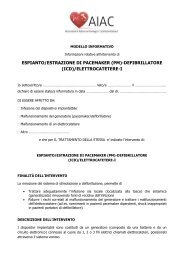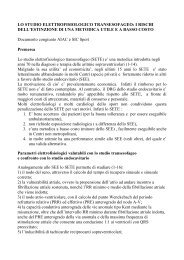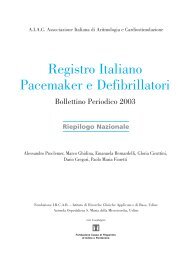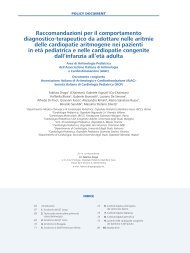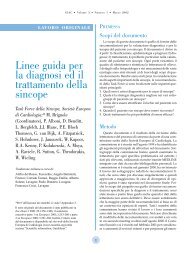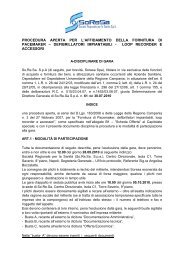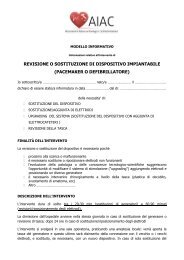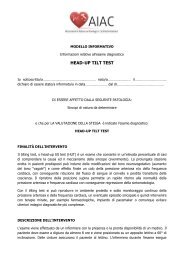Testo completo - Associazione Italiana di Aritmologia e ...
Testo completo - Associazione Italiana di Aritmologia e ...
Testo completo - Associazione Italiana di Aritmologia e ...
Create successful ePaper yourself
Turn your PDF publications into a flip-book with our unique Google optimized e-Paper software.
In<strong>di</strong>cazioni all’impianto <strong>di</strong> pacemaker nei blocchi atrio-ventricolari acquisiti in pazienti adulti<br />
nici <strong>di</strong> scompenso car<strong>di</strong>aco), verosimilmente legati<br />
alla presenza del blocco AV (livello evidenza <strong>di</strong><br />
tipo C);<br />
b. aritmie car<strong>di</strong>ache o altre situazioni patologiche che<br />
richiedano trattamento con farmaci che causano<br />
bra<strong>di</strong>car<strong>di</strong>a sintomatica, per riduzione dell’automatismo<br />
del focus <strong>di</strong> scappamento (livello evidenza<br />
<strong>di</strong> tipo C);<br />
c. documentazione <strong>di</strong> asistolia ≥3 secon<strong>di</strong> o ogni<br />
tipo <strong>di</strong> ritmo <strong>di</strong> scappamento con frequenza car<strong>di</strong>aca<br />
inferiore a 40 bpm in pazienti svegli e senza<br />
sintomi (livello evidenza <strong>di</strong> tipo B e C); (9, 10)<br />
d. blocco AV <strong>di</strong> III grado da ablazione della giunzione<br />
AV “Ablate and Pace” (livello evidenza C); (11)<br />
e. blocco AV post-operatorio, che non regre<strong>di</strong>sce<br />
dopo intervento car<strong>di</strong>ochirurgico dopo almeno<br />
10-15 giorni <strong>di</strong> tempo (livello <strong>di</strong> evidenza C); (12)<br />
f. malattie neuromuscolari con blocco AV, tipo <strong>di</strong>strofia<br />
muscolare miotonica, sindrome <strong>di</strong> Kearn-Syre,<br />
<strong>di</strong>strofia <strong>di</strong> Erb ed atrofia muscolare peroneale, per<br />
l’impreve<strong>di</strong>bile progressione verso <strong>di</strong>sturbi della<br />
conduzione AV (livello <strong>di</strong> evidenza C); (13-16)<br />
g. tachicar<strong>di</strong>a ventricolare bra<strong>di</strong>car<strong>di</strong>a <strong>di</strong>pendente.<br />
2. Blocco AV <strong>di</strong> II grado con bra<strong>di</strong>car<strong>di</strong>a sintomatica,<br />
in<strong>di</strong>pendentemente dalla sede del blocco (livello <strong>di</strong><br />
evidenza B).<br />
3. Blocco AV <strong>di</strong> II grado tipo 2, asintomatico.<br />
4. Blocco AV <strong>di</strong> II grado tipo 2:1, asintomatico, se a sede<br />
infranodale.<br />
5. Blocco AV <strong>di</strong> II grado tipo I, asintomatico, in cui allo<br />
stu<strong>di</strong>o elettrofisiologico si documenti la presenza <strong>di</strong><br />
blocco intrahisiano o sottohisiano.<br />
6. Blocco AV <strong>di</strong> III grado asintomatico con frequenza ventricolare<br />
me<strong>di</strong>a 0.30 sec) in pazienti<br />
con <strong>di</strong>sfunzione ventricolare sinistra e sintomatici<br />
per scompenso car<strong>di</strong>aco, nei quali la stimolazione<br />
sequenziale con intervallo AV inferiore comporti un<br />
3<br />
miglioramento emo<strong>di</strong>namico (livello <strong>di</strong> evidenza<br />
C). (17)<br />
4. Patologie neuromuscolari tipo <strong>di</strong>strofia muscolare miotonica,<br />
sindrome <strong>di</strong> Kearns-Sayre, <strong>di</strong>strofia <strong>di</strong> Erb, e<br />
atrofia muscolare peroneale con qualsiasi grado <strong>di</strong><br />
blocco AV (incluso blocco atrioventricolare <strong>di</strong> I grado),<br />
con o senza sintomi, per la possibile ed impreve<strong>di</strong>bile<br />
progressione dl <strong>di</strong>sturbo della conduzione AV<br />
(livello <strong>di</strong> evidenza B).<br />
Bibliografia<br />
1) Barold SS: In<strong>di</strong>cation for permanent car<strong>di</strong>ac pacing in first degree<br />
AV block: class I, II or III? Pacing Clin Electrophysiol<br />
1996;19:747-51<br />
2) Glickson M, Hayes DL, Nishimura RA: Newer clinical application<br />
of pacing. J Car<strong>di</strong>ovasc Electrophysiol 1997;8:1190-203<br />
3) Hayes DL: Evolving in<strong>di</strong>cation for permanent pacing. N Engl<br />
J Med 1996;334:89-97<br />
4) Strasberg B, Amat-Y-Leon F, Dhinigra RC et al.: Natural history<br />
of chronic second-degree atrioventricular nodal block.<br />
Circulation 1981;63:1043-9<br />
5) Dhingra RC, Denes P, Wu D et al. : The significance of second<br />
degree atrioventricular block and bundle branch block : observations<br />
regar<strong>di</strong>ng site and type of block. Circulation 1974;49:638-<br />
46<br />
6) Narula O: Clinical concepts of spontaneous and induced atrioventricular<br />
block. In: Mandel WJ, ed. Car<strong>di</strong>ac arrhythmias.<br />
Their mecchanisms, <strong>di</strong>agnosis and management. Philadelphia,<br />
PA; JB Lippincott 1987: 321-42<br />
7) Johansson BW: Complete heart block: a clinical hemodynamic<br />
and pharmacological study in patients with and without an<br />
artificial pacemaker. Acta Med Scand 1966; 180(suppl 451):1-<br />
127<br />
8) Edhag O, Swahn A: Prognosis of patiets with complete heart<br />
block or arrhythmic sincope who were not treated with artificial<br />
pacemakers: a long-term follow-up study of 101 patients.<br />
Acta Med Scand 1976; 200: 457-63<br />
9) Gregoratos G, Cheitlin MD, Conill A, et al.: ACC/AHA Guidelines<br />
for implantation of car<strong>di</strong>ac pacemakers and arrhythmias devices.<br />
A report of the American College of car<strong>di</strong>ology/America Heart<br />
Association Task Force on Practice Guidelines. J Am Coll Car<strong>di</strong>ol<br />
1998;31:1175-209<br />
10) Kim MH, Deeb GM, Eagle KA et al.: Complete atrioventricular<br />
block after valvular heart surgery and the timing of pacemaker<br />
implantation. Am J Car<strong>di</strong>ol 2001;87: 649-51<br />
11) Langberg JJ, Chin MC, Rosenqvist M et al.: Catheter ablation<br />
of the atrioventricular junction with ra<strong>di</strong>ofrequency energy.<br />
Circulation 1989;80:1527-35<br />
12) Glikson M, Dearani JA, Hyberger LK et al.: In<strong>di</strong>cations, effectiveness<br />
and long term dependency in permanent pacing after<br />
car<strong>di</strong>ac surgery. Am J Car<strong>di</strong>ol 1997;80:1309-13<br />
13) James TN, Fisch C: Observations on the car<strong>di</strong>ovascular involvement<br />
in Friedreich’s ataxia. Am Heart J 1963;66:164-75<br />
14) Roberts NK, Perloff JK, Kark RAP: Car<strong>di</strong>ac conduction in the


